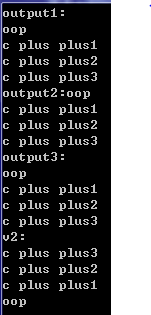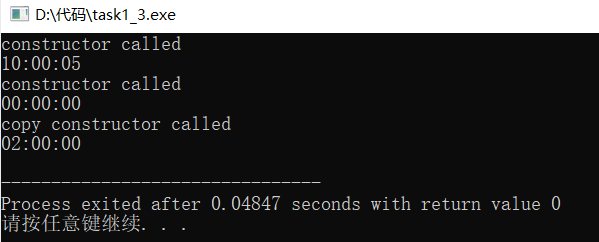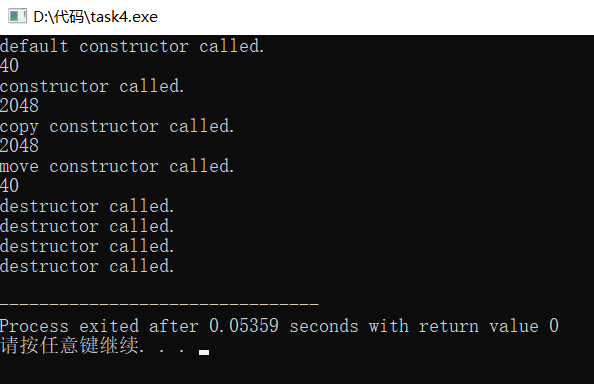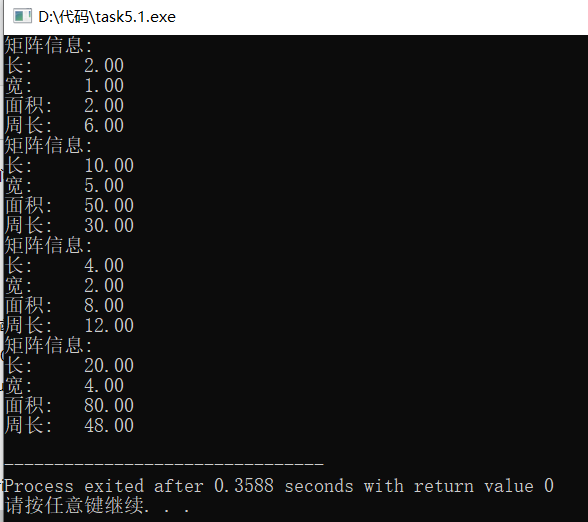实验1 类和对象(1)
1.实验任务1
task1_1
程序源码
#include<iostream> #include<string> #include<vector> int main() { using namespace std; string s1; string s2{"c plus plus"}; string s3{s2}; string s4=s2; s1="oop"; vector<string> v1; v1.push_back(s1); v1.push_back(s2+"1"); v1.push_back(s3+"2"); v1.push_back(s4+"3"); cout<<"output1:"<<endl; for(auto item:v1) cout<<item<<endl; cout<<"output2:"; for(auto p=v1.begin();p!=v1.end();++p) cout<<*p<<endl; cout<<"output3:"<<endl; for(auto i=0;i<v1.size();++i) cout<<v1[i]<<endl; vector<string> v2{v1.rbegin(),v1.rend()}; cout<<"v2:"<<endl; for(auto item :v2) cout<<item<<endl; }
测试结果

task1_2
程序源码
#include<iostream> #include<string> #include<vector> #include<cmath> #include<cstdlib> #include<time.h> template <typename T> void output(const T& obj) { for(auto item: obj) std::cout<<item<<" "; std::cout<<std::endl; } int main() { using namespace std; vector<int> v1{1,9,8,4}; v1.insert(v1.begin(),2022); v1.insert(v1.end(),2023); cout<<"v1: "; output(v1); v1.pop_back(); v1.erase(v1.begin()); cout<<"v1: "; output(v1); vector<string> v2{"《1984》","《动物农场》","《美丽新世界》"}; cout<<"v2: "; output(v2); }
测试结果

2.实验任务2
程序源码(已更换测试数据)
#include<iostream> using std::cout; using std::endl; class Point{ public: Point(int x0=0,int y0=0); Point(const Point& p); ~Point()=default; int get_x() const { return x;} int get_y() const { return y;} void show() const; private: int x,y; }; Point::Point(int x0,int y0):x{x0},y{y0}{ cout<<"constructor called."<<endl; } Point::Point(const Point& p):x{p.x},y{p.y}{ cout<<"copy constructor called."<<endl; } void Point::show() const{ cout<<"("<<x<<"," <<y<<")"<<endl; } int main(){ Point p1(5,6); p1.show(); Point p2=p1; p2.show(); Point p3{p2}; p3.show(); cout<<p3.get_x()<<endl; }
测试结果(已更换测试数据)

3.实验任务3
程序源码(已更换测试数据)
#include<iostream>
#include<iomanip>
using std::cout;
using std::endl;
class Clock{
public:
Clock(int h=0,int m=0,int s=0);
Clock(const Clock& t);
~Clock() = default;
void set_time(int h,int m=0,int s=0);
void show_time() const;
private:
int hour,minute,second;
};
Clock::Clock(int h,int m,int s):hour{h},minute{m},second{s}{
cout<< "constructor called" << endl;
}
Clock::Clock(const Clock& t):hour{t.hour},minute{t.minute},second{t.second}{
cout<< "copy constructor called" << endl;
}
void Clock::set_time(int h,int m,int s){
hour=h;
minute=m;
second=s;
}
void Clock::show_time() const{
using std::setw;
using std::setfill;
cout<< setfill('0') << setw(2) << hour <<":"
<< setw(2) << minute << ":"
<< setw(2) << second <<endl;
}
Clock reset(){
return Clock(0,0,0);
}
int main()
{
Clock c1(10,0,5);
c1.show_time() ;
c1=reset();
c1.show_time();
Clock c2{c1};
c2.set_time(2);
c2.show_time();
}
测试结果(已更换测试数据)

4.实验任务4
程序源码(已更换测试数据)
#include<iostream> class X{ public: X(); ~X(); X(int m); X(const X& obj); X(X&& obj) noexcept; void show() const; private: int data; }; X::X(): data{40}{ std::cout<<"default constructor called.\n"; } X::~X(){ std::cout<<"destructor called.\n"; } X::X(int m):data{m}{ std::cout<<"constructor called.\n"; } X::X(const X& obj):data{obj.data}{ std::cout<<"copy constructor called.\n"; } X::X(X&& obj)noexcept :data{obj.data}{ std::cout<<"move constructor called.\n"; } void X::show() const{ std::cout<<data<<std::endl; } int main(){ X x1; x1.show(); X x2{2048}; x2.show(); X x3{x2}; x3.show(); X x4{std::move(x1)}; x4.show(); }
测试结果(已更换测试数据)

分析
X x1;//默认构造函数被调用
X x2{2048};//定义的构造函数被调用
X x3{x2};//复制构造函数被调用
X x4{std::move(x1)};//移动构造函数被调用
析构函数在x4.show()后调用,顺序是x4,x3,x2,x1
5.实验任务5
程序源码
#include <iostream> #include <iomanip> class Rectangle { public: Rectangle(); Rectangle(double l, double w); Rectangle(const Rectangle & obj); ~Rectangle() = default; double len() const; double wide() const; double area() const; double circumference() const; void resize(int times); void resize(int l_times, int w_times); private: double length, width; }; Rectangle::Rectangle() : length{2.00}, width{1.00} {} Rectangle::Rectangle(double l, double w) : length{l}, width{w} {} Rectangle::Rectangle(const Rectangle & obj) : length{obj.length}, width{obj.width} {} double Rectangle::len() const { return length; } double Rectangle::wide() const { return width; } double Rectangle::area() const { return length * width; }; double Rectangle::circumference() const { return 2 * (length + width); }; void Rectangle::resize(int times) { length *= times; width *= times; }; void Rectangle::resize(int l_times, int w_times) { length *= l_times; width *= w_times; }; void output(const Rectangle &rect) { using namespace std; cout << "矩阵信息:" << endl; cout << fixed << setprecision(2); cout <<setfill(' ')<< setw(8) <<left<< "长:" << rect.len() << endl <<setfill(' ')<< setw(8) <<left<< "宽:" << rect.wide() << endl <<setfill(' ')<< setw(8) <<left<< "面积:" << rect.area() << endl <<setfill(' ')<< setw(8) <<left<< "周长:" << rect.circumference() << endl; } int main() { Rectangle rect1; output(rect1); Rectangle rect2(10, 5); output(rect2); Rectangle rect3(rect1); rect3.resize(2); output(rect3); rect3.resize(5, 2); output(rect3); }
测试结果



 浙公网安备 33010602011771号
浙公网安备 33010602011771号